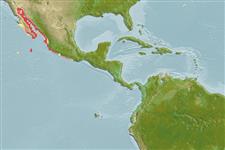Environment: milieu / climate zone / depth range / distribution range
Ökologie
seewasser riff-verbunden; tiefenbereich 1 - 50 m (Ref. 5222). Tropical; 32°N - 18°N, 115°W - 102°W
Eastern Central Pacific: southwest coast of Baja California throughout the Gulf of California to Jalisco, Mexico.
Size / Gewicht / Alter
Maturity: Lm ? range ? - ? cm
Max length : 86.0 cm TL Männchen/unbestimmt; (Ref. 40637); max. veröff. Gewicht: 9.6 kg (Ref. 40637)
Rückenflossenstacheln (insgesamt): 11; Rückenflossenweichstrahlen (insgesamt): 16-18; Afterflossenstacheln 3; Afterflossenweichstrahlen: 10 - 11. Distinguished by the following characteristics: greenish to greyish brown body color with small reddish brown spots and irregular pale spots and lines; fins with white margins; small portion of population exhibit xanthic pattern which is entirely bright yellow-orange, sometimes with few irregular black spots; depth of body contained 2.7-3.1 times in SL; head length 2.6-2.8 times in SL; angle of preopercle in adults with weakly-developed serrate lobe; posterior nostrils of large adults 2-3 times larger than anterior ones (Ref. 89707).
Prefers rocky areas in shallow water at depths of about 50 m. Adults feed on schools of the flatiron herring, Harengula thrissina, and anchoveta, Cetengraulis mysticetus when available; if not, on other schooling fishes or non-schooling fishes. Most feed at dawn and dusk, with a peak in activity about 20 minutes after sunset. Juveniles feed throughout the day on a variety of benthic fishes and crustaceans.
Life cycle and mating behavior
Geschlechtsreife | Fortpflanzung | Ablaichen | Eier | Fecundity | Larven
Heemstra, P.C. and J.E. Randall, 1993. FAO Species Catalogue. Vol. 16. Groupers of the world (family Serranidae, subfamily Epinephelinae). An annotated and illustrated catalogue of the grouper, rockcod, hind, coral grouper and lyretail species known to date. Rome: FAO. FAO Fish. Synop. 125(16):382 p. (Ref. 5222)
IUCN Rote Liste Status (Ref. 130435)
Bedrohung für Menschen
Harmless
Nutzung durch Menschen
Fischereien: weniger kommerziell
Mehr Information
ReferenzenAquakulturAquakultur ProfilZuchtlinienGenetikElectrophoresesVererbbarkeitKrankheitenVerarbeitungNutrientsMass conversion
PartnerBilderStamps, Coins Misc.LauteCiguateraGeschwindigkeitSchwimmstilKiemenoberflächeOtolithsGehirngrößeSehfähigkeit
Tools
Zusatzinformationen
Download XML
Internet Quellen
Estimates based on models
Preferred temperature (Ref.
123201): 20.6 - 26.8, mean 22.4 °C (based on 24 cells).
Phylogenetic diversity index (Ref.
82804): PD
50 = 0.5000 [Uniqueness, from 0.5 = low to 2.0 = high].
Bayesian length-weight: a=0.00933 (0.00429 - 0.02028), b=3.04 (2.87 - 3.21), in cm total length, based on LWR estimates for this Genus-body shape (Ref.
93245).
Trophic level (Ref.
69278): 4.5 ±0.80 se; based on food items.
Generation time: 11.9 ( na - na) years. Estimated as median ln(3)/K based on 1
growth studies.
Widerstandsfähigkeit (Ref.
120179): niedrig, Verdopplung der Population dauert 4,5 - 14 Jahre. (K=0.09).
Fishing Vulnerability (Ref.
59153): High to very high vulnerability (67 of 100).
Nutrients (Ref.
124155): Calcium = 22.1 [13.6, 39.6] mg/100g; Iron = 0.449 [0.244, 0.783] mg/100g; Protein = 18.6 [16.8, 20.3] %; Omega3 = 0.131 [0.083, 0.208] g/100g; Selenium = 35.6 [18.8, 68.7] μg/100g; VitaminA = 137 [45, 467] μg/100g; Zinc = 0.808 [0.556, 1.143] mg/100g (wet weight);
